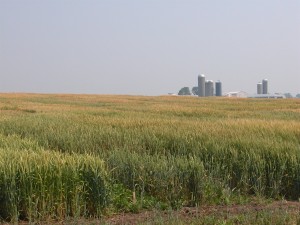Wisconsin Winter Wheat Disease Update – May 6
Damon L. Smith, Extension Field Crops Pathologist, University of Wisconsin-Madison
Brian D. Mueller, Graduate Research Assistant, University of Wisconsin-Madison
Winter wheat in research plots, and also adjacent production fields, was scouted in southern and south central Wisconsin during the week of May 2. Wheat at these locations ranges from Feekes 5 to Feekes 7. Wheat in general looks very good. Weather in the major wheat production area of Wisconsin has been generally dry this spring. This has resulted in very little disease pressure. We have been actively scouting for stripe rust considering reports from other states and have been unable to find any trace of rust, even in susceptible cultivars. As mentioned in a previous post, Septoria leaf blotch has been identified in low levels at some locations, however, the dry weather has lead to little progress of this disease. Powdery mildew has also been nearly nonexistent at this point.
Weather forecasts for the week of May 9 look to include some rain events. This may result in increased risk of disease onset, so this situation should be monitored carefully. We will continue to scout research plots, variety trials, and production fields for wheat diseases. As we move closer to the Feekes 8 growth stage (emerging flag leaf) the decision to spray fungicides will need to be made at that time. Remember that protecting the flag leaf from active foliar disease can be important, as that single leaf can be responsible for the majority of the grain yield of that plant. In Wisconsin, in years where leaf disease like Septoria leaf blotch or stripe rust have been active at the Feekes 8 growth stage, we have observed a significant increase in grain yield with fungicide applications at this time. However, if conditions remain dry during this growth stage, fungicide application may not be necessary. Weather over the next several weeks will guide this decision-making process. If you are interested in learning more about effective fungicides and fungicide application timing for wheat, please visit the FUNGICIDE INFORMATION webpage or also check out fungicide efficacy trial summaries from past years on the SUMMARIES webpage.
After the Feekes 8 growth stage, the next critical growth stage for making a fungicide application decision will be at Feekes 10.5.1 growth stage or the start of anthesis. This application of fungicide will be applied to target Fusarium had blight (FHB or scab). The field Crops Pathology laboratory will continue to monitor the Wisconsin wheat disease situation. Please be sure to check back periodically for any new updates.



